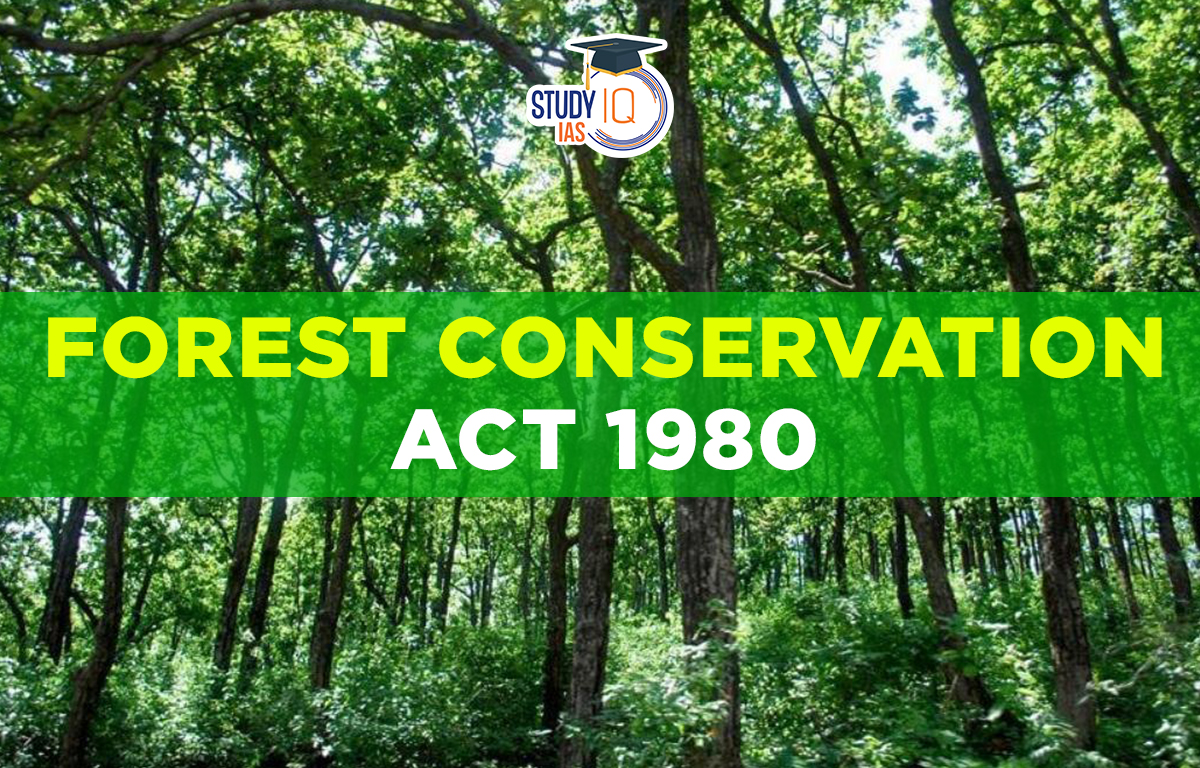Table of Contents
Context: The Supreme Court has ordered all States and Union Territories to complete the identification of forests in their jurisdiction in letter and spirit.
Forest Conservation Act 1980
The Forest Conservation Act 1980 is an important legislation enacted by the Government of India to regulate the diversion of forestland for non-forestry purposes. The Act was passed in response to the growing concern over the rapid depletion of India’s forests, which had serious environmental and ecological consequences.
- It was enacted to consolidate the law related to forests, the transit of forest produce and the duty leviable on timber and other forest produce. It came into force on October 25, 1980.
- The Act deals with the four categories of forests, namely reserved forests, village forests, protected forests, and private forests.
- Section 2 of the Act lists four criteria where permission of the Central Government is required for any action of the State regarding:
- Declaring that any reserved forest ceases to be reserved.
- Use of forestland for non-forest purposes.
- Leasing forest to any private person.
- Declaring that any forest land may be cleared of trees that have grown naturally in that land for reforestation.
|
Fact |
| Degree of protection – Reserved forests > Protected forests > Village forests |
Objectives of Forest Conservation Act 1980
The Forest Conservation Act 1980 seeks to balance the competing interests of development and environmental conservation. Its key objectives include:
- To conserve forests and ensure their sustainable management.
- To regulate the diversion of forestland for non-forestry purposes, such as mining, industrial projects, or infrastructure development.
- To ensure that any diversion of forestland is done only for a specific purpose and with the prior approval of the central government.
- Compensate for any loss of forest cover that may occur due to such diversions by undertaking afforestation and reforestation activities.
Forest Conservation Act 1980: Salient Features
The salient features of the Forest Conservation Act 1980 aim to regulate the diversion of forestland for non-forestry purposes, ensure the sustainable use of forest resources, and promote afforestation and reforestation activities. These include:
| Feature | Description |
| Central government approval | The Act mandates that the diversion of forestland for non-forestry purposes can only be approved by the central government. This requirement ensures that decisions related to forest diversion are made at the national level, with a focus on balancing economic development and environmental conservation. |
| Compensation for loss of forest cover | The Act requires the payment of compensation for the loss of forest cover due to the diversion of forestland. The amount of compensation is based on the net present value of the diverted forestland, and the funds collected are utilised for afforestation and reforestation activities. |
| Consultation with state governments and tribal communities | The Act mandates that state governments and tribal communities be consulted before approving the diversion of forestland. The consultation process ensures that the views of local stakeholders are taken into account and their concerns are addressed. |
| Mandatory undertaking for compensatory afforestation | The Act requires that an equal area of non-forest land be afforested or reforested as a compensatory measure for the loss of forestland due to diversion. The undertaking for compensatory afforestation is mandatory, and non-compliance can result in penalties. |
| Deemed forests | The Act recognises the concept of “deemed forests,” which refers to areas that are not officially classified as forests but are ecologically sensitive and have forest-like characteristics. Such areas are also subject to the Act’s provisions and require the central government’s approval for any diversion. |
| Penalties for violation | The Act provides for penalties, including imprisonment of up to 15 months and a fine of up to Rs. 10,000, or both, for violation of its provisions. The penalties act as a deterrent and promote compliance with the Act’s provisions. |
Key Highlights of the Supreme Court’s Order
The Supreme Court has warned that Chief Secretaries of States and Administrators of Union Territories will be held personally liable if they fail to constitute expert committees to identify forests in their jurisdiction within a month. Additionally, the court has mandated the preparation of consolidated records of these lands within the next six months.
Non-Compliance with the Van (Sanrakshan Evam Samvardhan) Adhiniyam Rules, 2023
- The Centre’s legal representative pointed out that most States have not completed the consolidation of forest land records as required under Rule 16(1) of the Van (Sanrakshan Evam Samvardhan) Adhiniyam Rules, 2023.
- Rule 16 mandates that “forest-like areas” and unclassed and community forest lands identified by expert committees be protected under law.
Amendments to the Forest (Conservation) Act, 1980
The Forest (Conservation) Act, 1980, was enacted to prevent deforestation and maintain ecological balance.
What Did the 2023 Amendments Change?
- Introduced Section 1A, which narrowed the definition of ‘forest’ to:
- Declared forests
- Lands recorded as forests in government records after 1980
- Concerns Raised by Petitioners:
- Petitioners argued that Section 1A weakened forest protection by excluding nearly 97 lakh sq km of undeclared forest lands
In August 2023, the Forest (Conservation) Act was substantially amended to name it Van (Sanrakshan Evam Samvardhan) Adhiniyam, 1980. The amendments created a lot of debate and controversy. Important changes are:
- Narrowed Scope of “Forest Land”: The amendment makes it explicit that the Act will essentially cover:
- Land notified or declared as forest under the Indian Forest Act, 1927, or any other law for the time being in force.
- Lands indicated as forest in government records as of or after October 25, 1980.
- This does not include lands that were diverted for non-forest purposes before December 12, 1996, and perhaps some “deemed forests” not specifically shown as such, which have been criticised as contravening the Godavarman judgment in spirit.
- Exemptions for Strategic/Linear Projects: Exempts certain categories of land from the coverage of the Act, namely:
- Land up to 100 km of international border, LoC, or LAC for strategic linear national importance and national security projects.
- Land up to 10 hectares for security-related infrastructure.
- Land up to 0.10 hectares for public utility projects along roads and rail tracks in specific locations.
- Enlarged “Forestry Activities”: The Bill contains a wider enumeration of activities not regarded as “non-forest purposes” and hence not subject to prior approval, e.g.,
- Building of zoos, safaris, eco-tourist facilities, and training infrastructure in the forest, if government-owned and included within an approved plan.
- Survey and investigation operations (e.g., reconnaissance, prospecting) which do not entail felling of trees.
- Assignment of Forest Land: The lease assignment of forest land provision to private parties has been made applicable to government companies as well.
- Preamble Addition: A new preamble has been added, highlighting the achievement of national goals for Net Zero Emissions by 2070 and forest carbon stock maintenance.
| Supreme Court’s Stand on the Definition of ‘Forest’ |
|
Forest Conservation Act 1980: Previous Amendments
The Forest Conservation Act 1980 has been amended several times over the years to address various issues and make it more effective in conserving forests and regulating the diversion of forestland for non-forestry purposes. Some of the notable amendments are:
| Amendment | Key Features |
| Amendment in 1988 | This amendment introduced the concept of “deemed forest” and brought all forestland under the purview of the Act, regardless of its legal classification. |
| Amendment in 1991 | This amendment made the central government’s approval mandatory for the diversion of forestland for non-forestry purposes, even if it is less than one hectare. |
| Amendment in 2003 | This amendment made it mandatory for the user agency to provide an undertaking to carry out compensatory afforestation before the diversion of forestland. |
| Amendment in 2015 | This amendment introduced the provision for granting forest clearance through a transparent online process, which is now known as the Forest Clearance Portal. |
| Amendment in 2017 | This amendment allows state governments to carry out compensatory afforestation activities on non-forest land with the approval of the central government. |
Limitations of Forest Conservation Act 1980
While the Forest Conservation Act 1980 is an important piece of legislation that has helped to protect India’s forests and regulate the diversion of forestland for non-forestry purposes, it has certain limitations that have prevented it from achieving its full potential. Some of the limitations are:
- Limited Implementation: Despite the Act’s provisions, forest diversion for non-forestry purposes continues to take place, sometimes illegally. The implementation of the Act has been weak in some areas, leading to the degradation and loss of forest cover.
- Inadequate Compensation: The Act provides for the payment of compensation for the loss of forest cover due to the diversion of forestland, but the amount is often inadequate, and the funds are not always utilised for afforestation and reforestation activities.
- Limited Tribal and Community Participation: The Act requires consultation with the affected tribal communities before approving the diversion of forestland, but in practice, their participation is often limited, and their concerns are not adequately addressed.
- Lack of Transparency: The decision-making process for forest diversion under the Act lacks transparency, making it difficult for stakeholders to understand the basis for the approvals.
- Limited Scope: The Act focuses primarily on the conservation of forests and the regulation of forestland diversion, but does not address issues such as forest management, biodiversity conservation, and sustainable use of forest resources.
- Exemptions: The Act provides exemptions for certain categories of projects, such as those related to national defence and security, which may lead to the diversion of forestland without adequate scrutiny.
Forest Conservation Act 1980 UPSC
The Forest (Conservation) Act, 1980, is an important topic for the UPSC (Union Public Service Commission) exam, especially for the Environment and Ecology section. The Act is a crucial piece of legislation that aims to protect India’s forests and regulate the diversion of forestland for non-forestry purposes.
Aspirants should have a good understanding of the salient features of the Act, including the central government’s approval for forestland diversion, the requirement for compensation for the loss of forest cover, and the consultation process with state governments and tribal communities.


 Ramsar Sites in India 2025 List: Names, ...
Ramsar Sites in India 2025 List: Names, ...
 List of National Parks in India 2025, Ch...
List of National Parks in India 2025, Ch...
 Bonnet Macaques: Habitat, Features, Beha...
Bonnet Macaques: Habitat, Features, Beha...

























